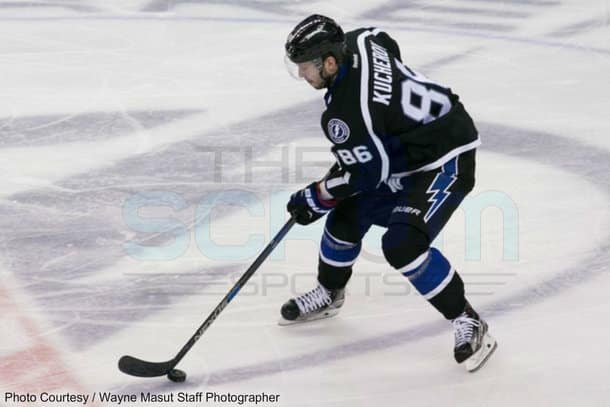
One-by-one, the dominoes began to fall during the summer for the Tampa Bay Lightning. Steven Stamkos took less money to re-sign after flirting with unrestricted free agency. Then Victor Hedman signed a huge extension for less money than he would’ve gotten on the open market had he become an unrestricted free agent in the summer of 2017. Alex Killorn signed a long-term deal. Andrei Vasilevskiy also got a raise. Even J.T. Brown, Vlad Namestinikov, and Nikita Nesterov received new, albeit short-term, contracts. But as summer gave way to fall, and the World Cup of Hockey came and went, one question has lingered over the Lightning:
Is Nikita Kucherov going to get a new contract soon?
The 23-year-old Kucherov, who has risen from a talented, struggling rookie to one of the top young wingers in the NHL over the span of the last three seasons, is currently holding out of the Lightning’s training camp until he gets a new deal as a restricted free agent. Tampa Bay general manager Steve Yzerman would love to have him under contract, but there’s this pesky little thing called the salary cap that is causing some issues. As of this writing, the Bolts only have just a little over $5.5 million in salary cap space to work with. And when you take a look at what Kucherov has done over the course of his NHL career so far, he’s worth more than $5.5 million a year. How so, you might ask? Well, let’s take a look at the numbers as well as what contracts other notable young RFA’s received from their respective teams this offseason (ages are at the time of this writing).
Nikita Kucherov, 23, Lightning, Unsigned
Regular Season Career: 211 games played, 68 goals, 81 assists, 149 points, plus-50, nine game-winning goals
Playoff Career: 45 Games Played, 22 goals, 20 assists, 42 points, plus-20, three game-winning goals (two in OT)
Sean Monahan, 21, Flames, Signed 7-year deal worth $6.375 million per year in the offseason
Regular Season Career: 237 games played, 80 goals, 79 assists, 159 points, minus-18, 15 game-winning goals
Playoff Career: 11 games played, 3 goals, 3 assists, 6 points, minus-3, 0 game-winning goals
Nathan MacKinnon, 21, Avalanche, Signed 7-year deal worth $6.3 million per year in the offseason
Regular Season Career: 218 games played, 59 goals, 94 assists, 153 points, plus-9, 13 game-winning goals
Playoff Career: Seven games played, 2 goals, 8 assists, 10 points, plus-2, one game-winning goal (in OT)
Filip Forsberg, 22, Predators, Signed 6-year deal worth $6 million per year in the offseason
Regular Season Career: 182 games played, 60 goals, 73 assists, 133 points, plus-3, nine game-winning goals
Playoff Career: 20 games played, 6 goals, 4 assists, 10 points, minus-10, one game-winning goal
Mark Scheifele, 23, Jets, Signed 8-year deal worth $6.125 million per year in the offseason
Regular Season Career: 227 games played, 58 goals, 87 assists, 145 points, plus-36, seven game-winning goals
Playoff Career: Four games played, 0 goals, 1 assist, 1 point, minus-2, 0 game-winning goals
All five of these players are among the top forwards in the league under the age of 24, and in a growing trend across the NHL, the Flames, Avalanche, Predators, and Jets all skipped signing their young stars to bridge deals and immediately gave them long-term extensions. A bridge deal has been a very common practice in the NHL, and is typically handed out after a player’s entry-level contract ended. It’s a deal where a player is given a raise for a couple of years, but not a massive raise. It’s essentially a deal saying, “We like what we see so far, but we want to see a little more before we throw serious money your way.”
The contracts handed out to Monahan, MacKinnon, Forsberg, and Scheifele were based on not only what they’ve done so far in their careers, but also on what kind of players their teams believe they will continue to develop into over the duration of those contracts. In addition, skipping the bridge deal option for long-term deals also works out in favor of those teams, as it keeps their players under contract for several years while still rewarding them with significant raises that won’t put a strain on their salary cap.
Which brings us to the situation in Tampa Bay.
When you look at the regular season stats for Kucherov compared to the other four players on this list, they’re all pretty similar. But what sets Kucherov apart from the likes of MacKinnon, Forsberg, Scheifele, and Monahan is the playoff production. Granted, Kucherov has been on a stacked Lightning roster that has made two deep playoff runs in a row, but he has not been a spectator. He’s been one of the main cogs in the machine for this Bolts team in both the regular season and postseason, coming up with huge goals on multiple occasions. If the other four guys on this list are worth at least $6 million a year, how much is Kucherov worth? At least $6.5 million a year, right? Maybe $7 million?
Unfortunately for the Lightning, the salary cap situation is extremely tight, which makes paying Kucherov what the market deems worthy at this time unlikely unless they make a trade to free up cap room. And very rarely are trades made right before this season starts. At this moment, who would be a trade candidate anyway? The obvious name that comes to mind is goalie Ben Bishop, who was close to being dealt during this past summer and will be an unrestricted free agent next summer. However, there isn’t a trade market out there for goalies at this time. That could change as the season progresses and there’s a team or two whose goaltending becomes a liability (hello, Dallas), which would free up some much-needed cap space of $5.95 million. They could ask Valtteri Filppula to waive his no-movement clause to move his $5 million cap hit, but that’s not a guarantee. Jason Garrison and Braydon Coburn have no-trade clauses that those players would have to waive for any deals to happen. Killorn doesn’t have a no-trade clause this year, but he just signed his extension this summer, so he’s not going anywhere. As it stands right now, the Lightning’s best option would be to try and convince Kucherov to sign a bridge deal for this season.
Although bridge deals aren’t quite as en vogue as they once were, it’s really the Lightning’s only option at this time. Signing Kucherov to a one-year deal in the neighborhood of $5-5.25 million would give him a significant raise, keep the Bolts under the salary cap, get one of their best players back in the lineup, and buy them some time before they have to make major roster decisions in the summer of 2017. On the other hand, if Tampa Bay signs Kucherov to that type of a deal now and he outperforms it by having a career year (which he’s capable of), it might cost the Lightning even more money per year in the long-term. Unfortunately, they don’t have much of a choice right now if they want him in the lineup for the season opener on October 13th. Yzerman has worked his magic before, but convincing a star player holding out of camp to sign a short-term contract for less than he’s worth right before the start of the season might be his best trick yet. The challenge will be a tough one, but I wouldn’t bet against Yzerman in this case.
All salary cap information courtesy of capfriendly.com. All statistics courtesy of hockeyreference.com




